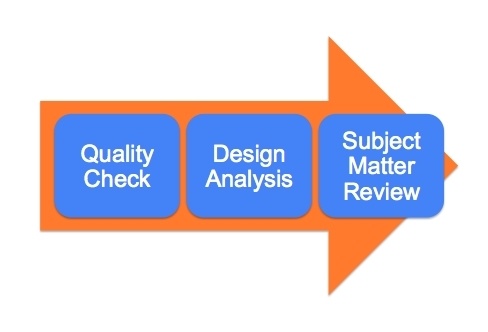Arranging a formal review of training resources can be a frustrating process. I tend to get a lot of comments about spelling and grammar, or about the colors and imagery I have used. But I struggle to get meaningful feedback on the accuracy and quality of the information within my resources.
This isn’t surprising. Most people are never formally taught how to review documents. It’s a skill you pick up as you go along. And there are different types of review – ranging from simple proofreading to complex subject matter analysis. I believe very few people understand that there are different types of review, and never develop skills at the more complex review types.
I have started implementing a three-step review process for training resources. I run each review in sequence, and ask different people to complete each type of review. When I send resources for review, I always give specific information on what aspects of the resources I want feedback on. Here are my three review levels, with the areas I ask people to review in each.
3 Review Levels To Improve The Training Resource Review Process
- Quality check
Choose reviewers with good administrative and language skills. Personal Assistants or Team Administrators are generally good quality checkers.- Are there any spelling, grammar or punctuation mistakes?
- Are there any technical issues (bugs)?
- Is the language simple and easy to understand? Has Plain English been used?
- Design analysis
Choose reviewers with good understanding of instructional design or web design principles. Learning & Development specialists are best.- Does the structure of the resource make sense? Do the topics flow logically from one to the next?
- Is the resource easy to navigate? Can you quickly find information on a specific sub-topic?
- Is the look & feel of the resource appropriate (e.g. the appropriate colors, fonts & images for the subject matter)?
- Is the look & feel cohesive (e.g. do the colors, fonts & pictures work well together)?
- Will the resources meet the learning objectives of the project?
- Are the resources engaging? Will learners be bored or overwhelmed?
- Subject matter review
Choose reviewers who understand the content of the training. These are usually representatives of a business unit or a project team.- Is the information presented accurate?
- Have all the relevant points on this topic been discussed? Is any information missing?
- Are the most important points given the most attention?
- Are complex and confusing topics given enough attention?
- Have appropriate scenarios or activities been included? Do they relate to what the learners do in their day-to-day work?
6 Tips To Improve Your Training Review
- Run your reviews with a group in a meeting room. You can ensure the review happens in your timeframe, and focus your reviewers on the specific aspects you would like reviewed.
- Document all feedback you receive. Capture the name of the person that gave the feedback, where in the resource is relates to (e.g. a page or slide number), and what change they would like made. Add a section where you can track whether you have made the change, and provide explanation if you have not.
- Remember that you still own the resource. You do not need to incorporate every piece of feedback you receive. But you should provide a valid justification if you do not incorporate a specific piece of feedback.
- Thank your reviewers for their time. Make sure they understand that you appreciate their input.
- Set end dates for each review round, and fix the number of reviews that can take place. You may not always be able to stick to these dates, but they do help to focus your reviewers and yourself.
- Have an end date. No resource will ever be perfect and please everyone. You must be willing to reach a point of ‘good enough’ and start using what you have developed. You can always do another review in six months and make more changes then.

